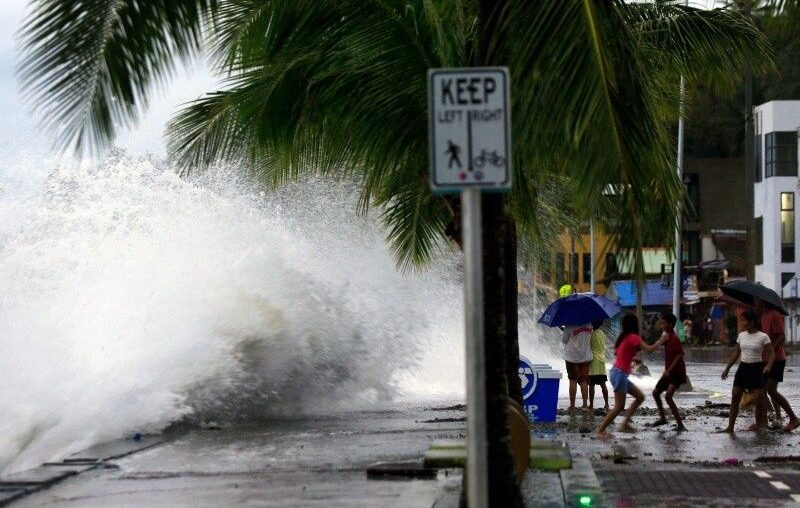 Manila, Philippines – Coastal communities across Luzon and parts of the Visayas are bracing for potentially life-threatening storm surges as Super Typhoon Pepito continues to batter the country with its powerful winds and torrential rains. Authorities have raised storm surge warnings in at least 15 provinces, including Metro Manila, amid concerns of widespread flooding and destruction.
Manila, Philippines – Coastal communities across Luzon and parts of the Visayas are bracing for potentially life-threatening storm surges as Super Typhoon Pepito continues to batter the country with its powerful winds and torrential rains. Authorities have raised storm surge warnings in at least 15 provinces, including Metro Manila, amid concerns of widespread flooding and destruction.
The Philippine Atmospheric, Geophysical and Astronomical Services Administration (PAGASA) has categorized Pepito as a Category 5 typhoon, with maximum sustained winds of 215 kilometers per hour and gusts reaching up to 260 kilometers per hour. As of the latest advisory, the typhoon’s eye was located 150 kilometers east of Aurora province, moving west-northwest at 20 kilometers per hour.
Storm surges as high as three meters have been reported in parts of Polillo Island, Quezon province, and Albay, according to PAGASA. In affected areas, residents were seen evacuating to higher ground as massive waves began pounding coastal villages. “We have issued mandatory evacuation orders for communities in low-lying areas,” said Quezon Governor Angelina Reyes. “Our priority is to ensure zero casualties as Pepito continues to intensify.”
Metro Manila and provinces such as Aurora, Quezon, Camarines Sur, Albay, and Sorsogon are under storm surge alerts. Residents in these areas are warned to prepare for waves of up to two meters in height. PAGASA also extended warnings to parts of the Visayas, including Samar and Leyte, as Pepito’s wide radius affects areas far from its eye.
In Albay, Governor Noel Rosal reported that seawater had already engulfed parts of Legazpi City’s coastal road, damaging fishing boats and displacing families. “Our disaster response teams are on high alert, but we need more resources to accommodate evacuees,” Rosal said. In Metro Manila, flood-prone areas such as Navotas and Malabon have been placed under heightened monitoring. Local authorities have advised residents to secure essential belongings and relocate to evacuation centers if needed.
Polillo Islands bore the brunt of Pepito’s initial landfall. Video footage aired on GMA Network showed storm surges sweeping through residential areas, with strong winds toppling trees and ripping off roofs. Some residents had to wade through chest-deep water to reach safety. “This is the worst storm surge we’ve experienced in years,” said local fisherman Ramon Cruz. “Our boats are gone, and many homes are underwater.” Emergency responders in Polillo are working round-the-clock to rescue stranded families and deliver relief supplies. However, access remains challenging due to downed power lines and debris blocking major roads.
The National Disaster Risk Reduction and Management Council (NDRRMC) has activated its highest level of alert, mobilizing thousands of personnel for search, rescue, and relief operations. Over 200,000 people have been preemptively evacuated, while more than 500 evacuation centers have been set up across Luzon and the Visayas. “Our teams are coordinating with local governments to address immediate needs such as food, water, and medical supplies,” said NDRRMC spokesperson Mina Ortega. “We urge residents to stay informed through official advisories and avoid venturing out unless absolutely necessary.”
In addition, the Department of Social Welfare and Development (DSWD) has prepositioned relief packs and emergency supplies in affected regions. The Armed Forces of the Philippines (AFP) and the Philippine Coast Guard (PCG) are also deploying assets for rescue missions and logistical support.
The typhoon’s impact is expected to take a toll on agriculture and infrastructure in the affected regions. Early assessments suggest significant damage to rice fields and fisheries, particularly in Central Luzon, the country’s agricultural hub. Environmental groups are also raising concerns about the long-term effects of storm surges on coastal ecosystems. “The destruction of mangroves and coral reefs will make these areas even more vulnerable to future disasters,” said environmentalist Maria Lopez.
As Super Typhoon Pepito continues its destructive path, the government is calling for unity and resilience. President Ferdinand Marcos Jr. has assured the public that all resources are being mobilized to assist affected communities. “Our people have faced countless storms, and each time, we have risen stronger,” Marcos said in a televised address. “Let us help one another and follow safety protocols to ensure everyone’s survival.”
With Pepito expected to remain within the Philippine Area of Responsibility until Tuesday, authorities emphasize that vigilance is critical. “The storm may pass, but the recovery will take time,” said PAGASA meteorologist Anna Reyes. “Let’s stay safe and prepared.” As storm surges continue to threaten lives and livelihoods, Filipinos in affected areas are urged to heed warnings and prioritize safety above all else.
Photo credit: AFP / Charism Sayat

